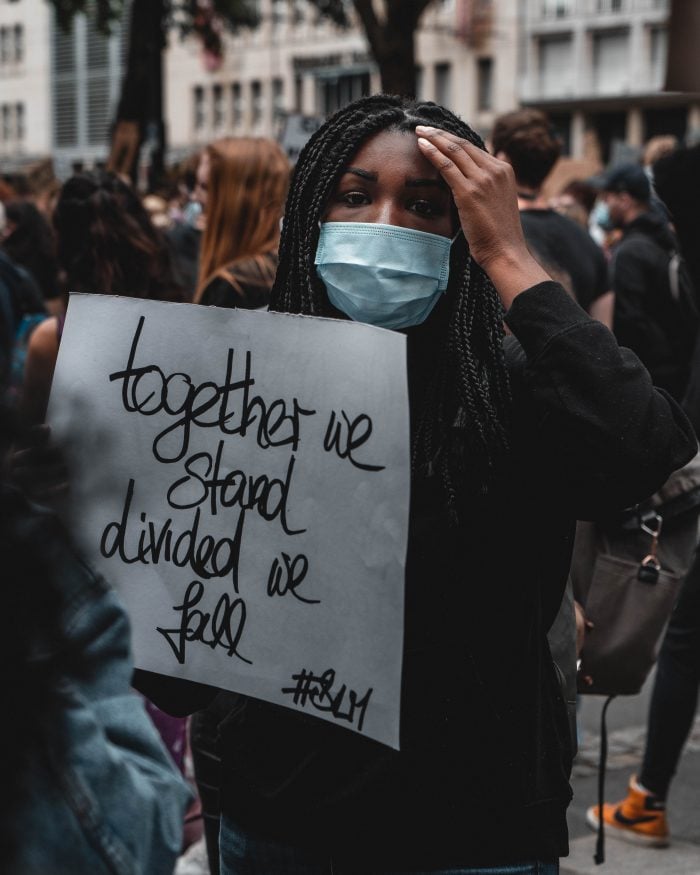The world has been turned upside down in a very short time, and the impact on our psychological well-being is profound.
Sometimes it feels like every day brings with it new challenges—many of which we’ve never faced before.
As the streets are rocked by those wanting systemic change, and COVID-19 continues to spread, we may find ourselves disoriented, overwhelmed, and unsure where to turn.
One way through these challenges is by being a good steward of our emotional experience.
When we attune, manage, and make good use of our feelings, we find our center, our stability, and our health. We find resilience.
For many of us, staying present to what’s emotionally coming up for us feels daunting. It can be anxiety-provoking and unsettling.
To avoid these uncomfortable feelings, maybe we go on an online shopping spree, hop on Facebook or Instagram for the umpteenth time, or check the news outlets hoping for a bit of good news that might quell our fears. Or perhaps we get caught up in circular worries that don’t seem to get us anywhere, and that don’t bring relief. We might even isolate, disconnect from the world around us, and shut down.
These responses are all coping strategies that we engage in to make us feel better. The problem is, they might momentarily take the edge off the symptoms, but they don’t get at the cause; they don’t last.
The solution lies in doing something that may seem counterintuitive.
In order to get somewhere better, we need to find a way to befriend our discomfort.
It’s natural to feel that giving in to our anxiety is going to make it worse, but we actually have research that shows that when we identify what’s going on for us emotionally, activity in our amygdala, the part of our brain that tells us that we’re in danger, calms down.
Here’s where the practice of mindfulness meditation is so useful: when we sit in meditation, all of the thoughts and feelings that we have in our everyday lives are going to be there with us like little visitors. And the more we sit with them in meditation practice and observe and become familiar with them, the more aware we become of our emotional experience in our daily lives.
Another thing that meditation shows us is that our emotions—including anxiety—don’t last forever. They have a beginning, middle, and end. It’s the things we do to avoid them that keep them hanging around.
If we allow ourselves to ride our emotional waves with openness and compassion, we soon find ourselves on the other side of it.
Use this meditation for sitting with emotions.
Take a moment to get comfortable and find the best position for you. You can shut your eyes if you’d like or just rest your gaze downward. Take a few deep breaths at your own pace. As you inhale, feel an expansion. And as you exhale, feel a release.
Take a moment to notice yourself sitting here, and acknowledge whatever thoughts and emotions you’ve shown up with, knowing that they’re completely normal and natural.
Now, gently move your attention away from your thoughts and emotions, and to the sensations in your forehead and around your eyes. Soften and let go of any tension. Allow your jaw to relax.
Become aware of your shoulders. Relax your upper arms, your lower arms, your hands, all the way down to the tips of your fingers. Let your hands rest easy and let go of any tension in your upper legs. Soften your knees, soften your lower legs, let your legs and feet sink into the ground.
Now, just notice the feeling of your breath moving in and out of your body at its own pace. Trust that your breath will find its natural rhythm, gently stepping out of your breath’s way. Breathing in, know you’re breathing in. Breathing out, know you’re breathing out.
Your body is vibrating with energy at every moment. The energy may be subtle. Whatever is there, see if you can bring a sense of curiosity, an openness as you slowly scan your body from head to toe, and become aware of all the sensations you’re experiencing. Just notice. Let your attention be called to whatever sensations might stand out.
Rest with your breath. Open to yourself. Your mind might get distracted and wander off. Don’t worry. If anxious thoughts or fears come up, be kind to them. See if you can open your heart to them the way a good parent would comfort a child.
If you feel discomfort, incline toward it gently and softly in your mind. Simply sitting. Moment to moment. Being fully present—fully with yourself. Coming back to that gentle wave of breath. Making space inside for thoughts and feelings to dissipate and pass.
This is a way to take care of ourselves—by coming back to ourselves in the present moment. And if those thoughts or emotions feel like too much, you can always just return to your breath and rest there.
When you’re ready, you can slowly open your eyes, gently come back to the room, and take in your surroundings. Take a few seconds to notice how you feel.
Mindfulness meditation grows our ability to attend to our internal experience, to be able to find the space to feel what we’re feeling and not be swept up in reactivity. Throughout our day, we can turn our attention inward to the emotions that arise inside of us. We can begin to simply accept what is there.
Now, more than ever, practicing mindfulness and meditation helps to develop our relationship with ourselves and to meet our emotional experience with more equanimity. This can make our experience during this unprecedented time feel less scary and threatening.






Read 0 comments and reply